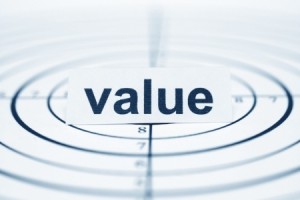 Value investors are always on the search for clues. Seeking out undervalued securities involves relentless digging, scratching, and a myriad of valuation techniques to derive conclusions. In frothy markets, value managers are also notorious for spotting red flags and smoke signals urging caution. I’d like to share one of those signals with you.
Value investors are always on the search for clues. Seeking out undervalued securities involves relentless digging, scratching, and a myriad of valuation techniques to derive conclusions. In frothy markets, value managers are also notorious for spotting red flags and smoke signals urging caution. I’d like to share one of those signals with you.
As a value manager, there is no phrase that makes me shudder more than “sum of the parts”. Immediately, I get the shakes. There are countless methods at a value investor’s disposal for deciphering value – discounted cash flow, price to book, price to earnings, PEG, dividend yield, and yes, at times, sum of the parts.
I was reminded of this recently listening to commentary on Yahoo’s (YHOO) announcement to spin off its Alibaba investment. A simple, back of the envelope calculation of Yahoo’s Alibaba (BABA) stake that afternoon sent Yahoo shares soaring in the after-market, and led many to quickly breakdown Yahoo’s share price by summing Yahoo’s parts, which now included a soon to be distributed stake in a widely followed and traded company. Let me explain, though, 5 reasons why you may want to pause when you hear analysts touting valuations derived from a ‘sum of the parts’.
- Valuing or investing based on a sum of the parts implies an ability to effectively value a number of corporate divisions. Have we not learned how difficult it is to value a single publically-managed corporation? Now, though, we’re able to put a value on multiple divisions within a corporation? – US operations, foreign, patents, real-estate, etc. Aren’t we mathematically increasing our odds of being wrong by introducing multiple other factors into the equation?
- Publically distributed information – If an analyst provides a thesis that XYZ (currently trading at $25) is actually worth closer to $50/share because the underlying value of the media company is $20, the intellectual property is worth $15, the international component $10, and a soon to be spun-off IPO another $5, I have to wonder – why is the stock not trading nearer $50 today? Does Carl Icahn not know this? And why would this information be publically available? Wouldn’t this analysis be assessed its own valuation near zero based on its distributor not valuing it enough to keep it proprietary?
- As a value investor, seeing a “sum of the parts” opinion usually reflects analysis which has not yet evolved into “throw in the towel” stage. Sum of the parts investing arguments seem to reveal more of a rationalization for owning (or recommending) a security. True value investors are looking for those last shoes to drop, and likely trying to spot analysts who’ve completely abandoned prior recommendations, instead of ones latching onto reasons for staying the course.
- Values may not remain constant. Markets are rivers, not frozen lakes. On Yahoo’s January 27 announcement, Alibaba ended the day at 102.94/share. A month later on February 26th, shares traded at $86, a 16% retreat during a month the company received regulatory inquiries from Chinese and U.S. authorities. During that identical timeframe, Yahoo shares subsequently receded as well. Sum of the parts may tend to wrongly assume that markets operate in a vacuum, than the fast-moving, always in flux operations that they are.
- Implication of a liquid market for the parts being summed. The public market may be liquid for shares of xyz, but the minute we start taking about the value of this department and that division, adjusting for liquidity seems to be abandoned. Underlying valuations may appear well on paper, but in order for those valuations to be realized somebody must be willing to liquefy that stake.
Who knows where particular situations like Yahoo and Alibaba will end up? One thing I do know is that I can’t produce a list of wildly successful investments where I remember analysts recommending shares based on a summation of the company’s parts, and I would challenge you to as well. When I hear investment arguments based on a sum of the parts, and “it’s like you’re getting Yahoo for free”, it makes me question more, not less.
Thanks for reading.
Heart Capital does not offer investment advice via this medium. Under no circumstance whatsoever do these postings, opinions, charts, or any other information represent a recommendation or personalized investment, tax, or financial planning advice.
Follow Ross on Twitter: @HeartCapital
No position in any of the mentioned securities at the time of publication. Any opinions expressed herein are solely those of the author, and do not in any way represent the views or opinions of any other person or entity.








